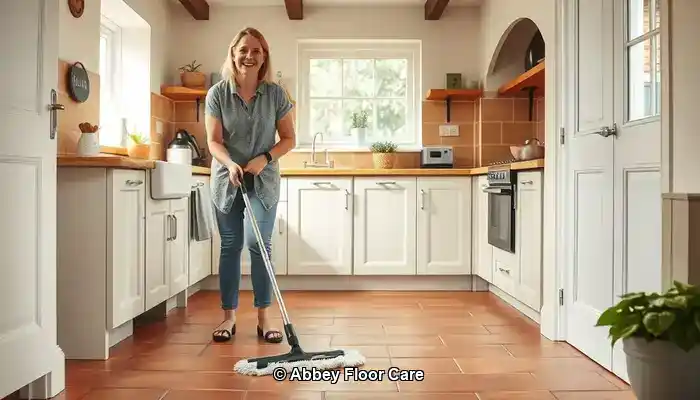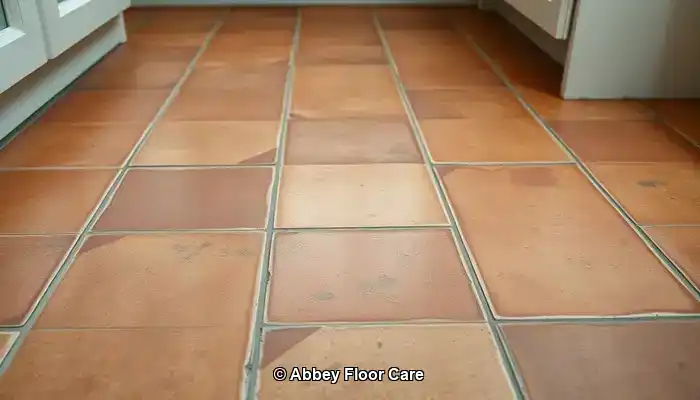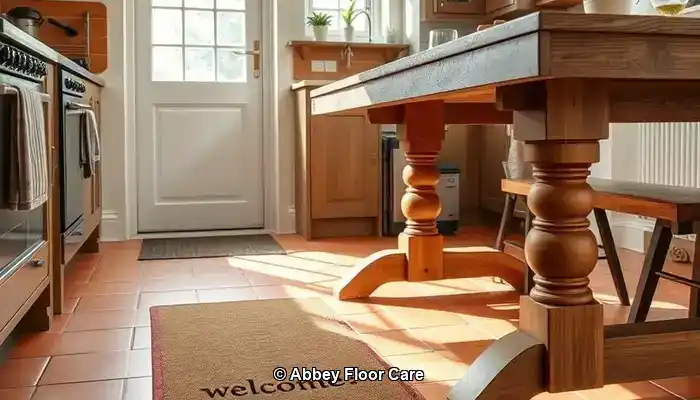
Tired of Dirty Terracotta? How to Keep It Clean Longer
Last Updated on September 29, 2025 by David
Key Takeaways for “Tired of Dirty Terracotta? How to Keep It Clean Longer”
-
- Terracotta is highly porous, making it prone to rapid dirt absorption, especially in damp climates like Surrey.
- Proper sealing is essential to prevent moisture and grime from penetrating the tile surface.
- Regular maintenance matters—daily sweeping and weekly mopping with pH-neutral cleaners help preserve the tile’s appearance.
- Avoid harsh chemicals and steam mops, which can damage the sealant and etch the tile.
- Eco-friendly products are recommended, especially in homes with pets or children.
- Professional restoration services offer deep cleaning and resealing for long-term protection.
- Strategic use of rugs and mats in high-traffic areas can reduce dirt transfer.
- Moisture management is key—ventilation and quick spill cleanup help prevent staining and mould growth.
Why Terracotta Gets Dirty Quickly

Terracotta tiles are a beautiful choice for flooring, especially in traditional or rustic-style homes across Surrey. Their warm tones and natural texture add character to any space. But despite their charm, terracotta is notoriously prone to getting dirty fast—and understanding why is the first step to keeping it clean.
Pro Tip: We recommend these products for daily Terracotta maintenance cleaning.

Fila Pro Floor Cleaner
|

LTP Floorshine
|

Vileda H2PrO Spin Mop System
|
Porosity: The Hidden Culprit
Terracotta is made from natural clay and fired at relatively low temperatures compared to other tiles. This process leaves the surface highly porous, allowing it to absorb moisture, oils, and dirt like a sponge. In everyday use, this porosity allows grime to settle deep into the tile, making it harder to remove with standard cleaning methods.
Unsealed terracotta is especially vulnerable. Without a protective barrier, even small spills or muddy footprints can leave lasting marks. Over time, this leads to a dull, stained appearance that’s difficult to reverse without professional help.
Surrey’s Climate Doesn’t Help
Surrey’s weather plays a significant role in how quickly terracotta floors get dirty. The region’s frequent rain and damp conditions mean more moisture is tracked indoors, especially in entryways and conservatories.
Homes near wooded areas or gardens are even more susceptible. Soil, pollen, and organic debris can easily find their way onto terracotta surfaces, especially if shoes aren’t removed at the door.
Everyday Habits That Speed Up Dirt Build-Up
Beyond the environment, daily routines can contribute to the problem. Using the wrong cleaning products—like acidic solutions or bleach—can strip away protective coatings and damage the tile’s surface. Steam mops, while popular, often force moisture into the tile, worsening the issue.
High-traffic areas, such as kitchens and hallways, are naturally more prone to wear. Without regular sweeping and mopping, dirt builds up quickly and becomes embedded in the tile’s texture.
Preventative Measures for Cleaner Terracotta

Keeping terracotta floors clean isn’t just about reacting to dirt—it’s about preventing it from settling in the first place. In Surrey homes, where damp weather and garden traffic are common, proactive care is essential to preserve the natural beauty of terracotta tiles.
Sealing: Your First Line of Defence
The most effective way to stop terracotta from getting dirty fast is to seal it properly. A high-quality, breathable sealant creates a protective barrier that repels moisture, oils, and grime. For Surrey properties, where humidity levels fluctuate, sealing helps prevent water absorption that leads to staining and mould growth.
Experts recommend resealing terracotta every 12 to 18 months, depending on foot traffic and exposure. In kitchens, hallways, and conservatories—areas that see daily use—more frequent sealing may be necessary. Always choose a sealant designed for porous stone and avoid glossy finishes that can trap dirt on the surface.
Wise Layout Choices: Rugs and Mats
Strategically placing rugs and mats can significantly reduce the amount of dirt reaching your terracotta tiles. Use heavy-duty doormats at entrances to trap mud and moisture before it spreads indoors. In high-traffic zones like hallways or under dining tables, area rugs provide a buffer that protects the tile from wear and tear.
For outdoor-connected rooms, consider washable runners that can be cleaned regularly. These not only preserve the tile but also add warmth and style to your space.
Moisture Management in Surrey Homes
Surrey’s climate is known for its rainfall and damp conditions, which can accelerate the build-up of dirt on terracotta. To combat this, use dehumidifiers in enclosed spaces and ensure good ventilation throughout your home. Wipe up spills immediately and avoid leaving wet items—like shoes or towels—on the floor.
If your terracotta is installed in a conservatory or garden room, consider installing blinds or UV filters to reduce condensation and sun damage. These minor adjustments can make a big difference in how your tiles age over time.
By combining sealing, intelligent design choices, and moisture control, Surrey homeowners can significantly reduce the rate at which terracotta floors become dirty. In the next section, we’ll dive into the best cleaning practices to maintain that fresh, natural look day after day.
Best Cleaning Practices for Terracotta Tiles

Even with proper sealing and preventative measures, terracotta floors still need regular care to maintain their natural beauty. The key is using the correct techniques and products that clean effectively without damaging the tile’s porous surface.
Daily and Weekly Maintenance Routine
In Surrey homes, where outdoor elements often make their way inside, daily sweeping or vacuuming is essential. Use a soft-bristle broom or a vacuum with a hard floor setting to remove dust, grit, and organic debris before it settles into the tile.
For weekly cleaning, mop with warm water and a pH-neutral cleaner specifically formulated for natural stone. Avoid soaking the floor—damp mopping is best. Excess water can seep into the tile and cause staining or mould growth, especially in older or poorly sealed installations.
Recommended Cleaning Products
Choose products that are gentle yet effective. Look for labels that mention “stone-safe,” “non-acidic,” or “pH-neutral.” In Surrey, where eco-conscious living is on the rise, many homeowners prefer biodegradable cleaners that are safe for pets and children.
Avoid multi-surface cleaners that contain bleach, ammonia, or citrus extracts. These can strip away sealants and etch the terracotta, leaving it vulnerable to future staining.
For stubborn spots, use a soft cloth and a diluted solution of stone cleaner. Never scrub with abrasive pads or wire brushes—these can scratch the surface and make the tile harder to clean over time.
What to Avoid: Harsh Chemicals and Steam
Steam mops may seem convenient, but they’re a poor match for terracotta. The high heat and moisture can penetrate the tile and weaken the sealant, leading to long-term damage. Similarly, acidic cleaners like vinegar or lemon juice—even when diluted—can erode the tile’s surface and cause discolouration.
Stick to gentle methods and constantly test new products on a small, inconspicuous area before applying them across the floor.
Professional vs DIY Terracotta Care
When it comes to maintaining terracotta floors, many Surrey homeowners start with DIY methods. While regular sweeping and mopping can help, there’s a point where professional care becomes not just helpful—but essential.
When to Call a Surrey-Based Tile Specialist
If your terracotta tiles are showing signs of deep staining, uneven colour, or surface wear, it’s time to consider expert help. Professional tile care specialists in Surrey use advanced equipment and stone-safe products that penetrate deeper than household cleaners. They can also assess whether your sealant has broken down and recommend the proper resealing schedule for your home’s specific conditions.
Restoration services often include deep cleaning, stain removal, and reapplication of breathable sealants that protect without altering the tile’s natural look. For older homes or heritage properties, specialists can even match the original finish to preserve authenticity.
Cost vs Longevity: Is Professional Worth It?
While DIY cleaning may seem more budget-friendly, it often leads to short-term results. Without proper sealing and deep cleaning, dirt continues to build up—requiring more frequent maintenance and risking permanent damage.
Professional care, on the other hand, extends the life of your terracotta floors. A single restoration session can restore colour, remove embedded grime, and protect the surface for months or even years. In high-traffic areas, such as kitchens or hallways, this investment pays off in reduced maintenance and enhanced visual appeal.
Surrey homeowners who value long-term property care and curb appeal often find that expert services offer peace of mind and better results. Plus, many local providers offer eco-friendly options and tailored maintenance plans to suit your lifestyle.
Eco-Friendly and Safe Cleaning Options
Terracotta’s earthy charm deserves care that’s just as natural. For Surrey homeowners who want to keep their floors clean without compromising on health or sustainability, eco-friendly cleaning is the way forward. Fortunately, modern products and techniques make it easy to protect your tiles—and your household—without harsh chemicals.
Non-Toxic Sealants and Cleaners
Traditional sealants often contain solvents that release volatile organic compounds (VOCs), which can linger in the air and affect indoor air quality. Today’s eco-friendly alternatives use water-based formulas that are low in VOCs and safe for use around children and pets.
When choosing a cleaner, look for labels that say “biodegradable,” “plant-based,” or “stone-safe.” These products are designed to lift dirt without damaging the porous surface of terracotta. Brands that specialise in natural stone care often offer concentrated solutions that can be diluted for everyday use, reducing waste and packaging.
Pet- and Child-Safe Alternatives
In busy Surrey homes, safety is just as important as cleanliness. Avoid bleach, ammonia, and acidic cleaners like vinegar, which can not only harm the tile but also pose risks to pets and young children. Instead, opt for gentle formulas made from coconut oil derivatives, citrus enzymes, or mineral-based ingredients.
For DIY enthusiasts, a simple mix of warm water and a few drops of castile soap can be surprisingly effective for light cleaning. Just be sure to test any homemade solution on a small area first to ensure it doesn’t affect the sealant or finish.
Sustainable Cleaning Habits
Eco-friendly care isn’t just about the products—it’s also about the habits. Use reusable microfiber cloths and mops instead of disposable pads. Sweep regularly to reduce the need for frequent wet cleaning. And when resealing, choose products with recyclable packaging and minimal environmental impact.
Many Surrey-based floor care professionals now offer green cleaning packages, using certified non-toxic products and sustainable methods. If you’re unsure where to start, booking a consultation with a local expert can help you build a routine that’s both effective and eco-conscious.
Keep Your Terracotta Floors Looking Their Best
Terracotta flooring brings warmth, character, and timeless appeal to Surrey homes—but its porous nature means it needs thoughtful care to stay clean and vibrant. By understanding why terracotta gets dirty quickly, sealing it properly, and adopting smart cleaning habits, you can dramatically reduce grime build-up and extend the life of your tiles.
Whether you’re managing a busy household or restoring a heritage property, the key is consistency. Daily sweeping, pH-neutral cleaning, and seasonal resealing go a long way in maintaining a well-maintained exterior. And when stains or wear start to show, don’t hesitate to call in a local specialist for professional restoration.
Eco-friendly products and safe cleaning routines also ensure your floors stay beautiful without compromising your health or the environment. With the right approach, terracotta can remain a stunning feature in your home for decades.
Ready to protect your floors the smart way? Contact us today for expert terracotta maintenance tailored to the unique conditions of Surrey. Let’s keep your home looking its best—naturally.
FAQs About Terracotta Maintenance
Terracotta floors are timeless, but they come with unique care requirements. Below are answers to the most frequently asked questions from Surrey homeowners looking to keep their tiles clean, protected, and beautiful.
How Often Should I Seal My Terracotta Tiles?
In most Surrey homes, terracotta should be sealed every 12 to 18 months. However, this depends on foot traffic, exposure to moisture, and whether the tiles are indoors or outdoors. Kitchens, hallways, and conservatories may need more frequent sealing. If your tiles start absorbing water or look dull, it’s time to reseal.
Can I Use Vinegar or Bleach on Terracotta?
No—vinegar, bleach, and other acidic or harsh cleaners can damage terracotta. These substances break down sealants and etch the tile surface, leading to permanent discolouration. Always use pH-neutral, stone-safe cleaners designed for porous flooring.
What’s the Best Mop for Terracotta Floors?
A microfiber mop is ideal. It traps dust and dirt without scratching the surface and uses minimal water, which is crucial for porous tiles like terracotta. Avoid sponge mops or steam mops, which can oversaturate the tile and weaken the sealant.
Is It Safe to Use DIY Cleaning Solutions?
Yes, but with caution. A mild mix of warm water and castile soap can work for light cleaning. Always test any homemade solution on a small, hidden area first. Avoid anything acidic or abrasive, and never use homemade cleaners on unsealed tiles.
What Should I Do If My Tiles Are Already Stained?
If stains have set in, professional restoration is your best option. Surrey-based tile care specialists can deep clean, remove embedded grime, and reseal the surface to restore the tile’s original colour and texture. DIY methods may worsen the damage if the wrong products are used.
19 Willow Rd,
New Malden
KT3 3RS
(01372)-664-337
We work throughout the country, just some of our work counties:
Copyright © Abbey Floor Care. Natural Stone Floor Restoration in Surrey and South West London FAQ - Privacy Policy - Terms And Conditions
Abbey Floor Care is a participant in the Amazon Services LLC Associates Programme, an affiliate advertising programme designed to provide a means for websites to earn advertising fees by linking to Amazon.co.uk. As an Amazon Associate, we earn from qualifying purchases.